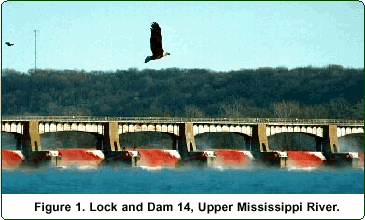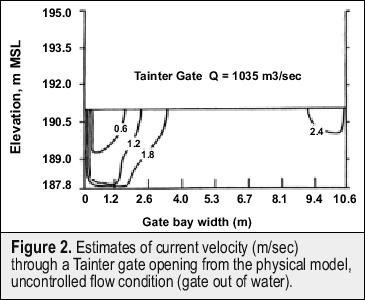|
The St. Paul District,
US Army Corps of Engineers and the US Geological Survey Upper
Midwest Environmental Sciences Center examined the effects of locks
and dams (Figure 1) on longitudinal fish movement in the Upper Mississippi
River (UMR). The objective of this Long
Term Resource Monitoring Program study was to estimate the opportunity
for upriver passage through dams by adult migratory fishes. I identified
UMR migratory fish species, estimated current velocities through
gate openings on UMR dams, compiled information on migration behavior,
and estimated the swimming performance of UMR migratory fishes.
I used this information in combination with river discharge and
dam operation records to estimate opportunity for upriver fish passage
through the dams. Another objective was to examine the records of
fish movements through UMR dams and to determine the head (difference
between tailwater and pool water levels) when the fish passed through
the dams. These results, reported in an earlier Project Status Report
(PSR96_04), summarized the findings
of 126 UMR fish mark-recapture and telemetry studies.
The objective of this Long
Term Resource Monitoring Program study was to estimate the opportunity
for upriver passage through dams by adult migratory fishes. I identified
UMR migratory fish species, estimated current velocities through
gate openings on UMR dams, compiled information on migration behavior,
and estimated the swimming performance of UMR migratory fishes.
I used this information in combination with river discharge and
dam operation records to estimate opportunity for upriver fish passage
through the dams. Another objective was to examine the records of
fish movements through UMR dams and to determine the head (difference
between tailwater and pool water levels) when the fish passed through
the dams. These results, reported in an earlier Project Status Report
(PSR96_04), summarized the findings
of 126 UMR fish mark-recapture and telemetry studies.
Existing Conditions
The UMR supports 143 species of indigenous fish and both recreational
and commercial fisheries. The UMR is impounded by a series of 29
navigation dams that restrict fish movements in the river system.
Design characteristics and operation of most UMR dams allow some
upriver and downriver fish passage. Downriver fish passage can occur
through the locks, through the gated sections of the dams, and over
the fixed-crest spillways. The navigation locks do not provide favorable
pathways for upriver fish passage. Most upriver fish passage probably
occurs through the gated sections of the dams. Opportunity for upriver
fish passage is dependent upon hydraulic conditions at the dams,
fish behavior, the timing of fish movements, and fish swimming abilities.
UMR Migratory Fishes
A total of 25 fish species are either known to be migratory in the
UMR or are probably migratory, based on their behavior in other
river systems. Upper Mississippi River migratory fishes include:
silver lamprey, lake sturgeon, shovelnose sturgeon, paddlefish,
goldeye, mooneye, American eel, Alabama shad, skipjack herring,
bigmouth buffalo, smallmouth buffalo, blue sucker, white sucker,
spotted sucker, blue catfish, channel catfish, flathead catfish,
northern pike, white bass, yellow bass, largemouth bass, smallmouth
bass, walleye, sauger, and freshwater drum.
Fish Swimming Performance
Fish ascending UMR dams are most likely to be swimming at the prolonged
level of swimming activity. Species, body length, physiological
condition, behavior, water temperature, concentration of dissolved
gases, turbidity, and light all influence fish swimming performance.
Models of prolonged swimming speed from literature sources were
used to estimate critical velocities for UMR fishes. Critical velocities
range from about 120 cm/sec for white bass to 42 cm/sec for northern
pike.
Hydraulic Conditions at UMR Dams
Current velocities through dam gate openings were estimated using
a physical hydraulic model of a typical UMR navigation dam and with
standard hydraulic equations. Velocities through the gated sections
of the dams are highest when dam gates are in the water, and a submerged
orifice flow hydraulic condition occurs in the gate openings.  When
the dam gates are raised from the water during higher levels of
river discharge, uncontrolled conditions exist, and open channel
flow occurs in the gate bay openings. When
the dam gates are raised from the water during higher levels of
river discharge, uncontrolled conditions exist, and open channel
flow occurs in the gate bay openings.
Estimates of current velocities through Tainter gate openings from
the physical model are as low as 0.6 m/sec under uncontrolled flow
conditions (Figure 2). Each navigation dam reaches its controlled
discharge capacity, when the gates are raised out of the water,
at different levels of river discharge (Figure 3). Opportunity for
upriver fish passage through dams is greatest during uncontrolled
conditions due to the lower velocities through the dam gate openings.
Dams with lower controlled discharge capacity may therefore present
more frequent and longer windows of opportunity for upriver fish
passage than dams with higher discharge capacity (Figure 3).
|
|
Estimating Opportunity for Upriver Fish Passage
Through analysis of UMR fish mark/recapture data, hydraulic conditions
at the dams, fish behavior and swimming performance information,
I estimated probability of opportunity for upriver passage through
UMR dams by adult UMR migratory fishes. Locks and Dams 1 and 19
present complete barriers to upriver fish passage. A limited number
of the 25 UMR migratory fishes with the highest swimming speeds
appear to have the best opportunity for upriver passage through
UMR dams during most water years. Lake sturgeon, shovelnose sturgeon,
paddlefish, white bass, yellow bass, and skipjack herring are strong
swimmers and tend to migrate high in the water column. (Skipjack
herring is a long distance migratory species restricted to the UMR
below Lock and Dam 19). The other migratory species appear to be
able to pass upriver through UMR dams only during periods when hydraulic
conditions are most favorable, when uncontrolled conditions at the
dams coincide with periods of upriver migration, or not at all.
Consequences of Restricted Habitat
The consequences of restricted fish passage through dams on UMR
fishes may include reduced reproductive success due to limited access
or delay in reaching suitable spawning areas, reduced growth rates
due to limited access to feeding areas, reduced over winter survival
due to restricted access to wintering areas, increased reproductive
success through concentration in tailwater areas below dams, and
increased exploitation rates due to concentration of fish and anglers
in tailwater areas. Young-of-year and small fish may be subject
to increased mortality and predation when stressed or disoriented
by downriver passage through dams. These consequences of restricted
fish passage through dams may combine to limit the geographic range
of some fishes and may reduce the size and health of fish populations
in the UMR.
Improving Fish Passage
Through UMR Dams Operational changes and structural modifications
at UMR navigation dams are possible. Further studies of hydraulic
conditions at UMR dams, the behavior of UMR migratory fishes, and
alternatives for improving upriver fish passage are recommended.
|
|
This report is a product of the Long
Term Resource Monitoring Program for the Upper Mississippi River
System.
For further information, contact
Daniel B. Wilcox
St. Paul District, US Army
Corps of Engineers
190 5th Street East
St. Paul, Minnesota 55101
Phone: 651-290-5276
E-mail: Daniel.B.Wilcox@usace.army.mil
U.S. Geological Survey
Upper Midwest Environmental Sciences Center
2630 Fanta Reed Road
La Crosse, Wisconsin 54603
Phone: 608/783-7550
Project Status Reports (PSRs) are preliminary documents whose purpose
is to provide information on scientific activities. Because PSRs
are only subject to internal peer review, they may not be cited.
Use of trade names does not imply U.S. Government endorsement of
commercial products.
All Project Status Reports are accessible through the Upper Midwest
Environmental Sciences Center’s website at http://umesc.usgs.gov/reports_publications/psrs/umesc_psr.html
|


 The objective of this
The objective of this  When
the dam gates are raised from the water during higher levels of
river discharge, uncontrolled conditions exist, and open channel
flow occurs in the gate bay openings.
When
the dam gates are raised from the water during higher levels of
river discharge, uncontrolled conditions exist, and open channel
flow occurs in the gate bay openings.